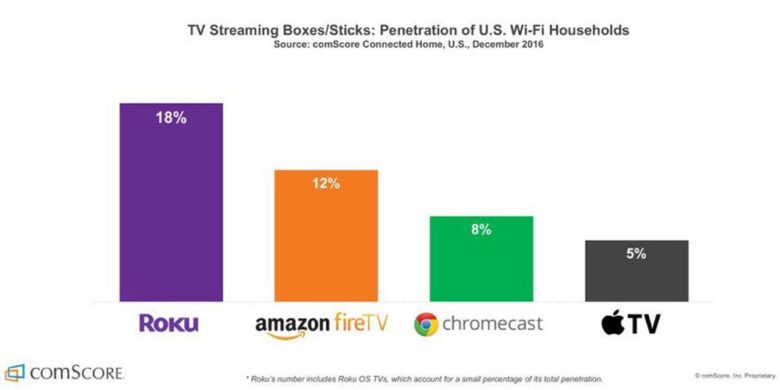Cupertino might not consider Apple TV a “hobby” any longer, but according to new data from comScore, the streaming device certainly is not viewed as a serious contender in the marketplace.
ComScore’s new figures show that — at the end of 2016 — Roku led the way for streaming TV boxes/sticks in the United States, with 18 percent penetration among Wi-Fi households. Amazon’s Fire TV followed on its heels with 12 percent, while Google’s Chromecast came third with 8 percent. Apple TV trailed in fourth place with just 5 percent.

Photo: comScore
It should be emphasized that this is 5 percent of surveyed U.S. Wi-Fi households, rather than 5 percent of houses with set-top boxes, so Apple’s numbers aren’t terrible. ComScore notes that live TV is still the dominant way that most U.S. customers consume their television, representing 84 percent of all viewing.
However, this is a fast-growing area and, as I’ve written before, it’s one that Apple previously dominated. Apple TV debuted back in 2007, making the device the oldest one on this list: Roku arrived in 2008, Amazon’s Fire TV in 2014 and Chromecast in 2015.
Therefore, Cupertino can’t fall back on claiming to be a newcomer like it can with Apple Music.
Right now, Apple’s upped its game to try and sell Apple TV. Today we reported that Apple is trying to come up with premium content bundles to sell the service, such as grouping together HBO, Showtime and Starz. It is also upping its focus on introducing Netflix-style original TV programming, although these shows are currently intended more as Apple Music add-ons rather than as something designed to sell the Apple TV.
Although Apple hasn’t released any official figures for Apple TV as of late, ComScore’s stats back up what others have said. Recent data from eMarketer suggested that Apple is currently “at the bottom of the U.S. connected TV market, behind Google Chromecast and Roku, with its share shrinking.”
Are you an Apple TV customer? Leave your comments below.
Via: 9to5Mac



10 responses to “Apple TV struggles to gain toehold in living rooms”
Got my AppleTV free from DirecTV Now. Have all the others (including 5 FireTVs) but the AppleTV 4 is the best UI for DirecTV Now
Until it’s got support for h265, mkv, and ideally 4K resolution, it’s not even a consideration for me.
VLC and Plex and many other AppleTV apps play H265, HEVC, UHD and mkv fine on the AppleTV.
4K? If your TV is big enough and you sit close enough, that would be important, but it’s amazing the number of people who run their big plasmas at 720P and don’t notice the difference.
Ah ok, thanks, good to know. I use VLC on Mac and iPhone – didn’t realise it was available for AppleTV. Have been basing my judgement on the base tech specs.
Good luck with that. They had better get the price down to affordable levels unlike their hardware
Why would Apple want to do that when premium hardware and prices have worked fine in all of their other market segments?
I own a gen 3 Apple TV and will not be upgrading until they at least support 4K.
Love mine – I have two of them in the house. Used Roku in the past and found it so unstable at times that I couldn’t even connect to Netflix. Perhaps since then they’ve improved their QA but since my AppleTV hasn’t had any problem in this area why go back. Also appreciate the more open architecture for app development. The AppleTV Plex app gets regular updates and improvements. Since there’s not a whole lot of 4K content I’m content with not having 4K support for now.
“18% Roku Stick penetration”
This article is not considering the whole picture as it considers only unit sales “market share” and ignores actual usage as well as cost and capabilities of these devices.
Apple absolutely dominates the TV EveryWhere market (paid streaming) according to the Adobe Digital Index with a massive 61.2% market share of which 22.3% came from the iPad, 18.2% were iPhones and 12.8% was from the AppleTV.
All of the Android platform combined (tablets and mobile) only managed a 9% market share and the Windows PC only managed 18%, Roku captured 7%, gaming consoles a pitiful 2%, Amazon Fire 1% and SmartTVs 0.7%.
Also, the cheap as chips $30 Chromecast for example is simply a streaming video dongle that requires other computers or mobile devices connect to it in order to stream content to the TV. The Chromecast isn’t a stand-alone device like the AppleTV which has it’s own on-screen interface and store as well as native apps all on the big screen.
At least the $30 Roku and the $80 Amazon FireTV can work independently although their app ecosystems and capabilities pall against Apple’s iOS.